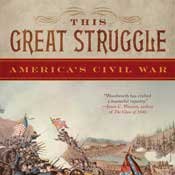The two most notable things about Steven E. Woodworth's "This Great Struggle: America's Civil War" (Rowman and Littlefield, 2011, $30) are the way it begins and the way it ends. The middle is a fairly dry and pedestrian history of the war's major battles and public controversies, albeit comprehensive and well written. But Woodworth's description of the events leading up to and following the war is notable in that it does not make the mistake that many Civil War historians make of conceding historical points to neo-Confederate revisionists. He tells the story of the 1860 elections and Reconstruction without attempting to sugarcoat southern motives, and the historical record, absent heavy spin, will seem shocking, bizarre and new. It's certainly shocking and bizarre, but the only new thing about it is Woodworth's refusal to invent a controversy where none exists.
The march to war, Woodworth argues, came about in two stages:
1. Secession. It has become a truism among southerners that the Civil War was about "states' rights," not slavery. This would have been news to the southern secessionist legislators, who regarded slavery as the dominant state's rights issue of their time and saw no distinction between the two. The sole reason given for secession in the South Carolina secession declaration of December 1860 was slavery policy—specifically, inadequate enforcement of the Fugitive Slave Act and the subsequent enfranchisement of slaves who had escaped to northern states (a theme that recurs in other secessional documents). The South took this to be a permanent problem after the election of the first serious anti-slavery president, Abraham Lincoln.
2. Northern response. Would the North capitulate to southern demands and revise federal policy to prevent slaves from escaping across state lines? Or would it "[l]et erring sisters go in peace," as newspaper publisher Horace Greeley suggested? Or would it attack outright? The recently elected Lincoln agreed to a compromise proposal: The seceding states would be left in peace, the Fugitive Slave Act would remain in place (allowing for the arrest and return of escaped slaves to the South), but federal garrisons would be maintained. The Confederacy was unsatisfied with this compromise and promptly attacked the federal garrison at Fort Sumter, initiating the American Civil War.
Why did southern states take such a hard line to preserve slavery? Because the southern economy was built on agriculture, and the southern aristocracy was so immensely powerful that it had little difficulty organizing a rebellion against the U.S. government. In the pre-radio, pre-television era, celebrities were generally local figures, and the South's local figures were either part of the aristocracy or solidly under its control.
The poor and working-class whites who made up the majority of the southern population found all of their leaders, all of their heroes and all of their institutions ready to do battle with the North. Few would have had the emotional courage to leave their entire culture behind, turn against their families and community leaders, and take a position that would have radically transformed their culture. White southerners faced much the same choice many times over the course of the next century, and for the most part, they continued to side with local white authority figures and institutions, to their own detriment and certainly to the detriment of those whose lives and ambitions did not conform to the old southern hierarchy.
In his discussion of Reconstruction, too, Woodworth does not concede any points to neo-Confederate revisionists, but he does note the changing motives of southern leaders—the shift in emphasis from the economic power of unpaid labor to the political power of voter suppression. The white southern aristocracy succeeded far more at suppressing black voter turnout than it did at depriving African Americans of literal citizenship—an agenda that still continues unabated to this day.
The question Woodworth never quite answers is why poor and working-class white southerners, who were willing to go along with this agenda leading up to a war that killed approximately 620,000 people and economically devastated the South, remained loyal to it through the Reconstruction phase and beyond, long after its limitations had become clear.
Northerners, southern African Americans and the white southern aristocracy generally took positions you would expect each group to take, given the circumstances they found themselves in. But the self-destructive political history of white southerners as a group is much harder to explain.
Freelance writer Tom Head is a lifelong Jacksonian. He has authored or co-authored 24 nonfiction books on a wide range of topics, is a civil liberties writer for About.com, and volunteers as a grassroots progressive activist.



Comments
Use the comment form below to begin a discussion about this content.